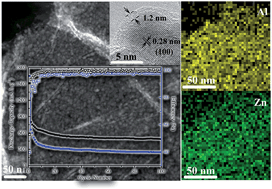An alumina stabilized ZnO–graphene anode for lithium ion batteries via atomic layer deposition†
Abstract
Atomic layer deposition (ALD) was applied to deposit ZnO on graphene aerogel, and this composite was used as an anode material for lithium ion batteries. This electrode material was further modified by an ultrathin Al2O3 layer via ALD to stabilize its electrochemical stability. These two metal oxides were uniformly immobilized on graphene frameworks, and the Al2O3 coating strongly improved the electrochemical performances of ZnO–graphene aerogel composite anodes. Particularly, the composite with 10 ALD cycles of Al2O3 coating (denoted as ZnO–G-10) exhibited a high initial discharge capacity of 1513 mA h g−1 and maintained a reversible capacity of 490 mA h g−1 after 100 cycles at a current density of 100 mA g−1. Furthermore, the capacity retention rate increased from 70% to 90% in comparison with its uncoated counterpart after 100 cycles. The ZnO–G-10 anode also showed good rate-capability, delivering a discharge capacity of 415 mA h g−1 at 1000 mA g−1. The improved electrochemical performance is attributed to the formation of an artificial solid electrolyte interphase layer, stabilizing ZnO and the electrolyte by preventing the aggregation of Zn/ZnO nanograins and the side reaction that would cause the degradation of anodes.


 Please wait while we load your content...
Please wait while we load your content...